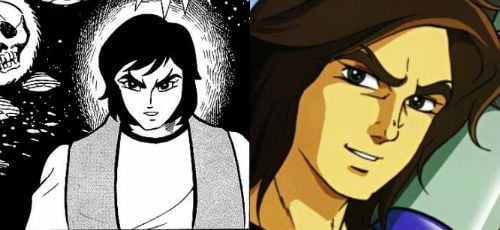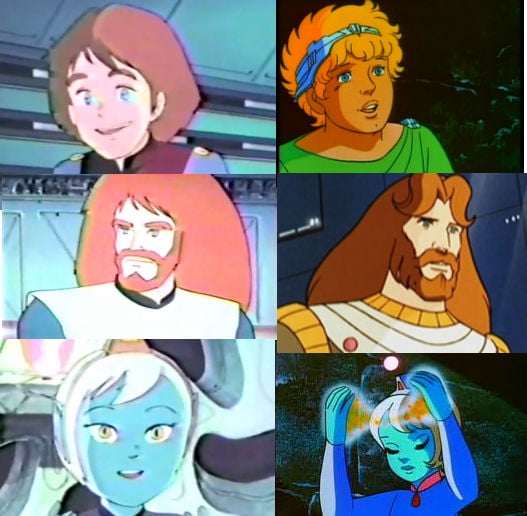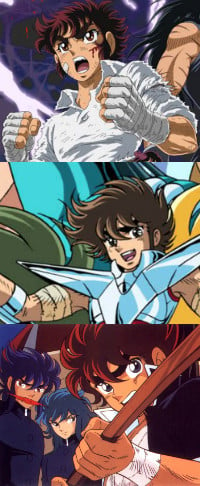The Mike Toole Show
Saint Shingo
by Michael Toole,
Well guys, I hate to have to keep talking about this, but we lost another one. Shingo Araki died this past Thursday. Like occasional creative partner Osamu Dezaki, who blew this pop stand last year, Araki was no spring chicken-- he was 72, after all, and all the chain smoking and those long shifts at Toei's anime factory probably didn't help. But Araki's one of those guys who's always been there for anime, and I just got the sense that he was going to keep going and going and going.
But who is this top-class craftsman of animation and character design, this kung fu master of taking already striking manga art and adding to it remarkable depth and nuance? I absolutely guarantee you, no matter where you are and no matter how old you are, you've seen his work-- and you might've even enjoyed it, too! Let's check it out.


I'll tell you one thing-- it's hard to get a read on Shingo Araki's personal life, or his background. It's been pretty easy to find biographical information about guys like Osamu Dezaki, who applied to join Mushi Pro right out of high school, or Shotaro Ishinomori, who studied directly under Osamu Tezuka. But even Shingo Araki's wikipedia page (the Japanese one, not the English one, natch) is light on details. We know that he got his start with color anime, working as a grunt on Kimba and Marine Boy before hitting more challenging fare like Attack no. 1, then joining Dezaki's wildly talented Tomorrow's Joe pit crew. His breakout hits would be 1973's Cutie Honey and Babel II which would make him a fixture at Toei for the rest of his career; he worked as animation director and character designer on each show, and it really shows. Take a look at this:

See, the first few waves of color anime were still pretty limited. Tezuka's Kimba, the White Lion team excelled in painting magnificent backgrounds, but the characters were extremely simple-looking. The same goes for early Tatsunoko efforts like Speed Racer and Hutch the Honeybee - Ippei Kuri's color sense is fabulous in those shows, but they still sport a very "flat" look, despite the cinematic framing and editing that was starting to set anime apart from western TV cartoons. But as you can see above, Araki wasn't satisfied with this approach. Along with fellow pioneers like Akio Sugino and Keiichiro Kimura, he started to impart a sense of depth and perspective to his character drawings that weren't really attempted in prior shows. His alteration of Babel II is minor, but Cutey Honey looks dramatically different from the manga - sleekier, sexier, and remarkably enough, still easy for Toei's legions of animators to crank out drawings of.
During the production of Cutey Honey, in fact, Shingo Araki came across what would become a pretty astonishing secret weapon - his partner! He teamed up with Cutey Honey animator Michi Himeno, but before they'd truly cement their partnership with the formation of Araki Production in 1975, the animator directed and designed Magical Girl Meg-chan in '74. If the magical girl genre saw its genesis with Mitsuteru Yokoyama's Sally the Witch, it came into bloom with Meg-chan, the fast-paced and funny chronicle of a young girl's journey to become a master witch. Araki had worked as an animator on 1970's Mahou no Mako-chan, so he was down with magical girls, but Meg-chan would be another showcase for his talent in creating excellent, memorable character designs.

As you can see, he took the opposite approach to some of his earlier stuff; Meg's adventures were drawn in great detail by a few different mangaka (most of the scanned pages I turned up were actually in color!), but Araki had to make something simple and memorable. If you look at Meg's eyes and her spiky, wavy hair, you'll see Araki's trademark style developing. The show was a success-- if you search pixiv, you'll still find disturbing fan art of it to this day! I think he did an even better job of fixing up Go Nagai's ragingly awesome super robot epic, UFO Robot Grendizer, the following year.

Here, Araki took Go Nagai's unabashedly primitive character art and transformed it into a vision of a tough, smoldering Japanese Clint Eastwood. Boys loved Grendizer for its crazy robot action, but a surprising amount of girls paid attention to space prince Duke Freed's awkward, doomed romance with earth girl Hikaru Makiba - and you can chalk that up to Araki's fine character artwork. After this point, something interesting happened - the newly-formed Araki Production duo signed on to Danguard Ace, yet another of Toei's attempts to sell toy robots to children. It was during this production that any doubts about the success of the Araki/Himeno partnership disappeared; she'd been signed on to adapt Leiji Matsumoto's original character designs to animation, while he would serve as animation director. But Araki injured his hand during production, and his wife simply took over for him. It would be the first fruit of a long partnership.
The next fruit, and one of the most famous, is 1979's Rose of Versailles. I often find myself thinking of Akio Sugino as its character designer, simply because Osamu Dezaki was involved in the production and those two were constant collaborators, but Sugino actually teamed up with Araki and Himeno for the series. And it was during this series that you really saw the strength of the partnership emerge - Araki excelled at drawing men, imposing figures with sharp features and steel in their eyes, while Himeno routinely drew the female characters, as soft and alluring as the men were hardened and intimidating, creating a beautifully matched counterpoint to her husband's style. In fact, I think the perfect way to sum up the pair is by looking at their work on Ulysses 31. Yes, I'm talking about Ulysses 31 again, deal with it! (Also, watch this hilarious recreation of the OP by hipsters using household items.) Anyway, the TV series we all know and love was actually preceded by a pilot film. The pilot is awfully similar to the finished first episode, but the artwork is very different. Shingo Araki did the character designs for that pilot. For the final series, his work was touched up and refined by Himeno. Let's take a look at how they stack up.

Interesting, isn't it? You can see that Araki had a clean, simple look in mind - but Himeno both made the characters look a touch more western, and gave them (particularly young Telemachus) that signature Araki Pro look. As the 80s progressed, Araki would find work in a variety of places-- character artwork for Taro the Dragon Boy here, animation direction for Captain Harlock: Endless Orbit SSX there-- but don't worry guys, in 1986 he did Saint Seiya.

You were all waiting for me to talk about Saint Seiya. Fine, I'm talking about Saint Seiya! Saint Seiya was already a popular Shonen Jump manga by Masami Kurumada when Toei brought it to the small screen. The series, about a gang of dudes fighting to gain mystical armor with godlike powers, was one of those shows that just had it-- it had that broad appeal, those larger-than-life stories, the great characters that viewers all over the world loved. It was a hit everywhere it went; of course, it somehow failed to reach American shores in a timely fashion-- we got it in 2004. Despite that, Saint Seiya is a huge favorite, a franchise that still generates new animation and merchandise every few years. The show was directed by Kozo Moroshita, who's certainly no slouch-- he directed Grendizer and the Sunbow Transformers cartoons, including the movie-- but he doesn't have that instant association with the series that its creator Kurumada does. But Shingo Araki? Yeah, he's the Saint Seiya guy, for sure! And you can bet that as well as he drew Seiya and Ikki and Hyoga suiting up and kicking ass with cosmos-exploding attacks, Himeno was right there backing him up with surprisingly elegant, restrained artwork of the show's female cast, like Athena and Seiya's mentor, Marin. Despite its broad popularity, Saint Seiya TV was left unfinished, only to be dusted off over a decade later for some more OVAs and films. The character designer for these new works? Why, that'd be one Shingo Araki. Himeno, of course, had his back.
Araki's next big project has become a favorite of mine in recent years, simply because it's finally (albeit via dubious means) available for English-speakers to enjoy. In 1991 he was tapped to provide character designs for Toei's TV version of Mitsuteru Yokoyama's long-revered adaptation of Romance of the Three Kingdoms. This series, focusing mainly on Liu Bei and his pals' fights against the corrupt Han dynasty, is full of big fights, machismo, and wonderfully fun, borderline superheroic takes on the story's heroes. The show sometimes looks a little too 1990s, but it suits Araki's macho-yet-elegant style wonderfully well. The entire thing has been fan subtitled; if I had my druthers, I'd somehow compel Toei to put it up region-free on Hulu so we could all enjoy it legally, but if you're curious enough, you'll probably be able to find it anyway.
Another product of the 1990s was an OVA series entitled Fuma no Kojiro. This is one of those weird 90s OVAs that always seemed to find their way onto the 6-hour EP-speed tapes of various odd, random anime that would make their way from club to club. At the time, everyone was kind of into Saint Seiya, so throwing Fuma no Kojiro, a simple enough combination of Fuma ninja clan warfare with high school misadventures, into the mix made sense. See, Saint Seiya mangaka Kurumada was actually heavily involved in the Saint Seiya anime (he scripted some of the episodes personally), and he was eager to turn more of his work over to Araki's able hands. The result is a show that looks an awful lot like Seiya, even though its tone and subject matter are different. This is because Kurumada has kind of the same "star system" idea as Osamu Tezuka, who created a set of "star" characters that he'd insert into stories over and over again. Kurumada's first and biggest manga "star" was Ryuuji Takane, the hero of his 1977 hit Ring ni Kakero. Seiya looks like Ryuuji, and so does Fuma's titular Kojiro.
Oh, did I say Ring ni Kakero? I guess I'm jumping ahead, but that's a show worth mentioning. A favorite on the fansub circuit, Ring ni Kakero was adapted for TV anime in 2004, more than 25 years after its debut as a manga. This is kind of interesting-- if you ask me, the anime's creation is a direct response to the runaway success of boxing tale Hajime no Ippo, which had hit airwaves a few years previous. Ring ni Kakero sits somewhere between the desperate, unhappy struggles of Tomorrow's Joe and the generally upbeat Ippo-- Ryuuji and his coach/manager sister stand in the shadow of his deceased father and taste defeat more than once, but they've got the guts and persistence to succeed. Amusingly, the anime came so far after the original manga that it ran concurrently with a sequel manga, which was entitled Ring ni Kakero 2. Consequently, to avoid confusion, the anime had to be called Ring ni Kakero 1! There's still new Ring ni Kakero anime coming out to this day, and it bears Araki Pro's signature look.
To bring things home, I'll point out what is unquestionably Shingo Araki's most widely-recognized work. If you're too young for Saint Seiya but too old for Ring ni Kakero, don't worry-- you saw his stuff on TV anyway, I'm betting. I'm talking, of course, about Yu-Gi-Oh. That's right, the show that was essentially How to Play the Card Game You're Going to Beg Mom and Dad to Buy For You was adapted from Kazuki Takahashi's original manga by a team that included a pair of character designers-- Michi Himeno and Shingo Araki. Araki wasn't involved in the seemingly endless reel of spinoffs, but he did handle design work for the first two TV shows. You didn't see the first one; nobody in the English-speaking world did, because it didn't have enough plot elements that could be turned into children's toys-- but chances are you saw the second one, and the movie. This isn't a great series, but it's something that an awful lot of people saw-- which means that an awful lot of people saw the nightmare fuel that is the Shingo Araki-designed Yugi's Grandpa.

Bwah! Anyway, I love Shingo Araki's artwork, and while he had a hell of a career, it's a shame that he's departed; this industry is weakened by it. By examining his body of work, it becomes obvious just how important good character design is in creating great animation. No one sticks around forever, but Araki has always been great at leaving you wanting more. Michi Himeno is still around, which is already leading to speculation on whether she'll continue to work on future Ring ni Kakero and Saint Seiya projects. What do you think? Is Seiya her destiny as well as his, or would it be like John Oates doing a sad, acoustic cover of "Method of Modern Love"? Finally, which was your favorite Shingo Araki production? Somebody's gonna be all mad that I didn't talk about Maple Town or Kindaichi Files, and if that person is you, let us know in the comments!
discuss this in the forum (27 posts) |
this article has been modified since it was originally posted; see change history